In the seventy years between last weekend’s coronation and our late Queen’s back in 1953, so much of our financial world has changed beyond recognition. After nearly 15 years of suffering near-zero rates, savers finally benefit from competitive returns on cash. The question many of you may now be asking is: Is cash now king? Our Senior Investment Specialist, Simon Durling, shares his thoughts in this week’s State of Play.
Key highlights from this week’s State of Play
- Is cash now king?
- Mind the erosion gap
- Why invest?
- Conclusion
Is cash now king?
This week sees the twelfth consecutive increase in interest rates following the decision by the Bank of England’s Monetary Policy Committee to raise rates by a further 0.25% in their commitment to tackling rising prices. This takes the base rate to 4.5%, with more increases forecast in the summer depending on the path of inflation, employment, and other macro-economic data. This means that since December 2021, when they made the first small increase from 0.10% to 0.25%, base rates have increased by 4.4% in just 18 months.1 This is the first such period of sustained ‘financial tightening’ (defined by less money in circulation and higher interest rates) we have seen since the Bank of England was appointed by Gordon Brown, the then Chancellor, in May 1997.2
Ever since the Global Financial Crisis, when central banks slashed rates to near zero and printed vast quantities of additional money to support the global economy, savers have suffered as rates have remained at record lows. However, once restrictions were lifted during the global pandemic, global economies reopened with a surge in demand, pushing up the price of commodities, including natural gas and energy, exacerbated by the conflict in Ukraine. In addition, supply chains were stretched as China pursued a zero-tolerance approach to COVID-19, disrupting the manufacture and distribution of goods and severely restricting supply, meaning the gap between demand and supply became much larger. After three decades of relatively low inflation supported by globalisation, inflation returned with a bang. Central banks misjudged the initial spike in prices and had to play catch-up.
Bank of England base rates since 2008
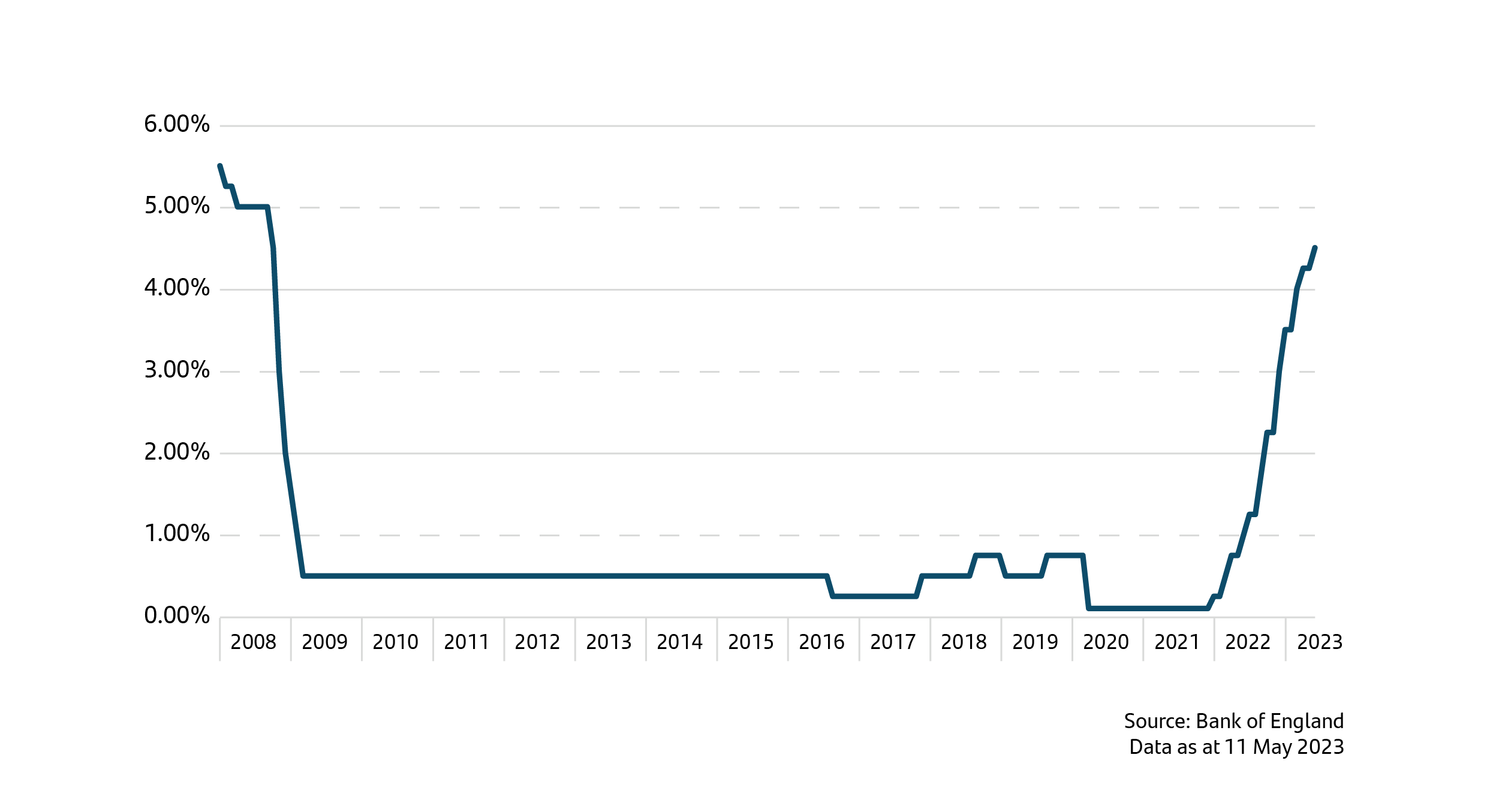
The last 18 months have seen the normalisation of interest rates as the central banks have had their finger firmly on the fast-forward button. Finally, after 15 years of poor interest rates, savers can start to smile as cash rates offer substantially higher interest than we have seen for a generation. However, does that mean investing all your wealth in a savings account is the best place for your money? Are you able to achieve your financial goals in the short, medium, and long-term by relying on savings rates alone? Let’s look at why this approach may have greater risks than at first glance and refresh on the reasons to invest, exploring some of the factors worth considering before concluding that cash is now king.
The importance of tax
Many savers may be delighted with the improvement in savings interest rates, but as I am sure we all know, how our savings or investments are taxed is a crucial element when considering what portion of your wealth is placed in a savings account and how much should be allocated for the long-term in an appropriate investment portfolio, assuming that is appropriate given your circumstances.
Clearly, ever since April 1999, savers and investors have had the advantage of their ISA allowance. The rules have evolved since their launch and now stand at £20,000 per person per tax year, whether this is in savings or investments. This allows either interest or growth to be tax-free. Anything outside of an ISA wrapper is subject to the taxation, depending on whether it is an investment or savings.
For savers, there is a personal savings allowance (PSA) which lets you earn interest on your savings without paying tax on that interest.3 The allowance you get depends on what rate of income tax you pay and while it sounds simple, it is always worth checking how you are affected individually depending on your financial circumstances:
- Basic-rate (20%) taxpayers: can earn £1,000 in savings interest per year with no tax
- Higher-rate (40%) taxpayers: can earn £500 in savings interest per year with no tax
- Additional-rate (45%) taxpayers: £0 – they do not get an allowance.3
The reason I highlight tax is because some may see a headline rate advertised and take that as the return they will receive on their savings. So, as a simple example, if you have £10,000 in savings and see a one-year fixed-rate savings bond account offering 4%, depending on your tax position and income, you may not receive all the 4%. A higher-rate taxpayer only receives £60 for every £100 in interest being paid. So, in this specific example, the 4% rate after tax only pays 2.4%.
Beware of the erosion gap
Obviously, depending on your time scales, I would argue inflation remains the biggest threat to our wealth. Policymakers of all types probably worry most about the impact of rising prices, normally implementing financial objectives, policies, and processes to monitor, measure and control inflation. Looking back over history, the periods where high inflation persisted coincided with cycles of real wealth reduction and economies stagnating. Clearly, as prices rise, the amount your savings or investment can buy will reduce over time if the returns or interest you receive fail to keep pace with the rise in the price of the goods and services you may choose to buy in the future.
In the last 15 years, inflation has been much lower by historical standards due to globalisation, which has kept goods prices suppressed, leaving savers with a gradual erosion over time. Below is a chart demonstrating how the erosion gap has now widened significantly even though savings rates have recently increased substantially, leaving savers with a dilemma. The data shows the Consumer Price Index (CPI) versus the Building Association (BSA) One-Year Fixed Saving Bond Rate. The data on the chart only shows until the end of February, as the BSA has yet to publish their latest figures. The chart below shows that while savers can be grateful for a sharp rise in the interest they receive on their savings, this is more than wiped out by rising prices, meaning the erosion gap is much bigger than we have become used to.
The erosion gap
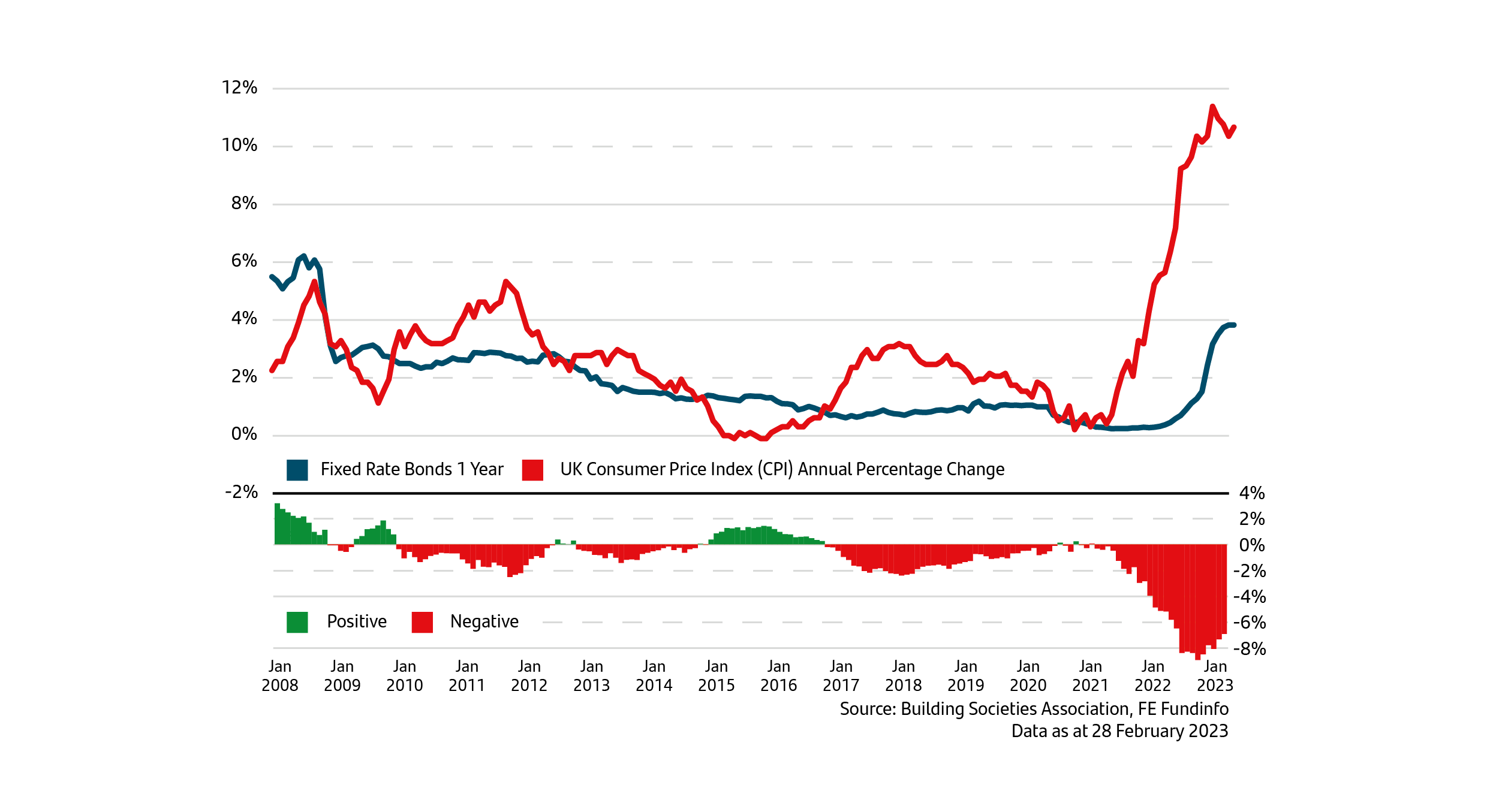
Also, it is important to use real-life examples to illustrate how this may impact your thinking. Let’s take buying a used car for £10,000 compared with ten years ago. If you just use the Bank of England’s simple inflation money tool, which uses the data from the Consumer Price Index (CPI), today’s used car should in theory cost £13,080.4 During this same ten-year period (2013-2023), the best-notice savings account (based on the Moneyfacts Index with £10,000 of savings) would have grown to just £10,818, leaving you short of buying the same equivalent car by £2,262.5 The problem with using very generic data, like CPI, is that it measures a wide basket of goods and isn’t specific to the purchase you may be spending your money on.
The reality using specific data looks very different. Below is the chart from the Autotrader Retail Price Index, measuring from February 2011 to April 2023. However, if we use the data from April 2013 over the same 10 years, it shows the cost of buying the average used car (all types of vehicles) has risen from £8,964 to £17,843. That is a real-life example of an increase of 99% - essentially the same car has doubled in price. During the same period, your savings have accumulated just over 8% in interest, leaving you over £8,000 short of buying the equivalent car!
One aspect of the chart that is scary for anybody looking to keep all their savings in cash is the most recent sharp rise in used car prices. The pandemic disrupted the manufacture of cars globally, reducing the supply of new registrations and, in turn, pushing up the cost of used vehicles. Now that new car production has increased to near pre-pandemic levels, the sharp increases in used car prices should ease in the next few months. However, it illustrates the risk of taking a simple index, like CPI, which measures a wide basket of goods and services, and applying this to your required level of return to help you reach your long-term, real (after inflation) target growth in your wealth. Trying to be more specific about what your spending plans and goals are over different time frames helps you be more realistic.
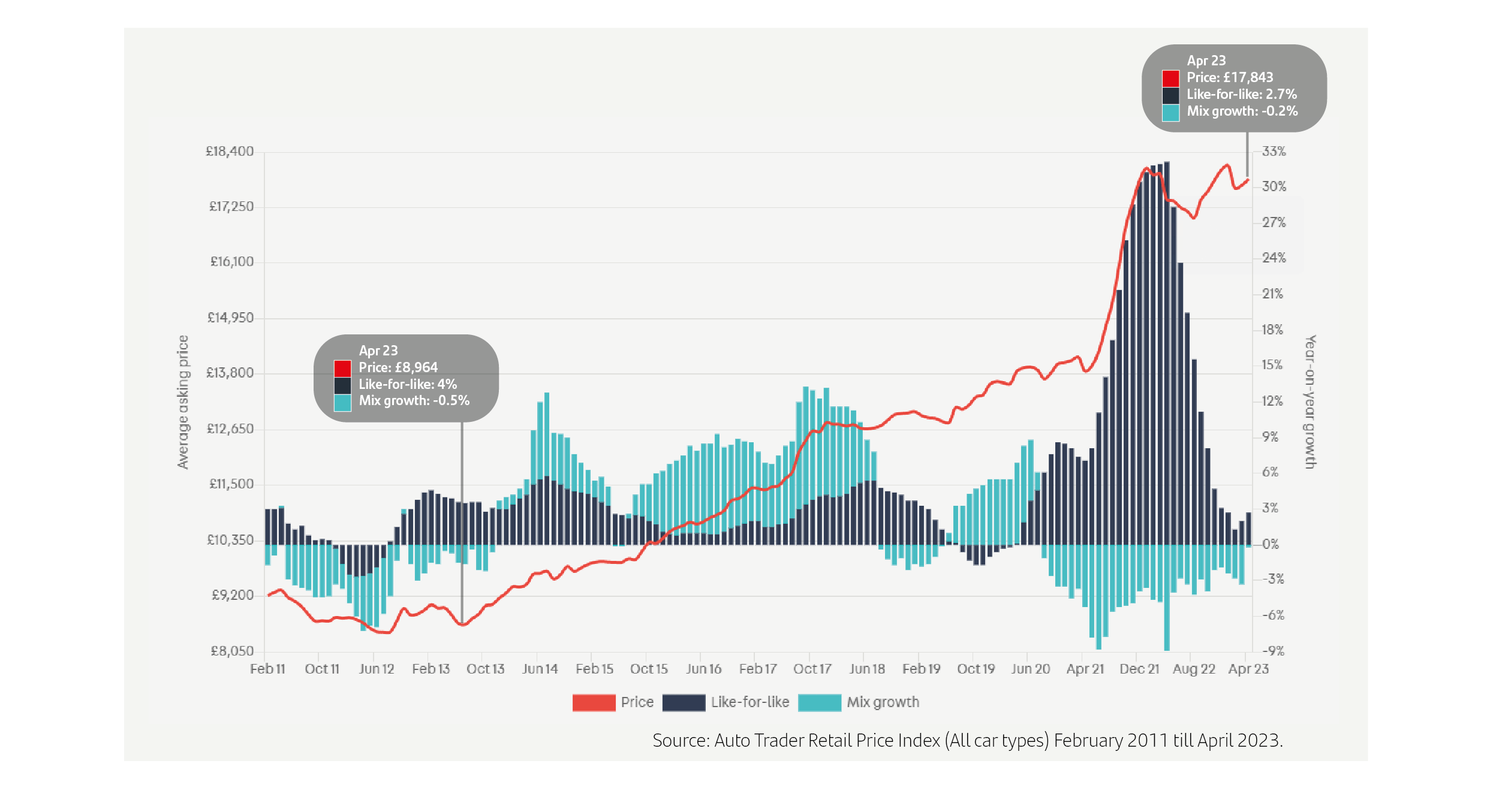 Big or small?
Big or small?
The final important aspect to mention is which bank or financial institution you may want to house your savings with. The recent banking turmoil triggered by the collapse of Silicon Valley Bank (SVB) has seen savers in the US move large chucks of their savings from small and regional banks to much larger, familiar institutions as they seek peace of mind knowing the bank holding their cash is sufficiently cushioned if there are any repeats of the recent crisis in confidence. While the regulations in the US have changed in recent years, the equivalent rules in both the UK and the EU mean that strict rules apply to all banks, ensuring they hold sufficient capital to withstand any such shocks. However, despite these rules, you may ask yourself the question about which organisation you choose for your savings and how much you hold in the account, remembering that the Financial Services Compensation Scheme protects £85,000 per eligible person, per bank, building society or credit union.6
Why invest?
This State of Play weekly update has in previous editions spelled out the reasons why people choose to invest, primarily driven by a desire to achieve returns in excess of inflation by accessing the returns available from bonds, shares, property, and other alternative asset classes. Clearly, any investment, depending on what assets you choose, will vary in value and experience volatility where the value goes down as well as up, with no guarantees.
Some FTSE companies have held their position
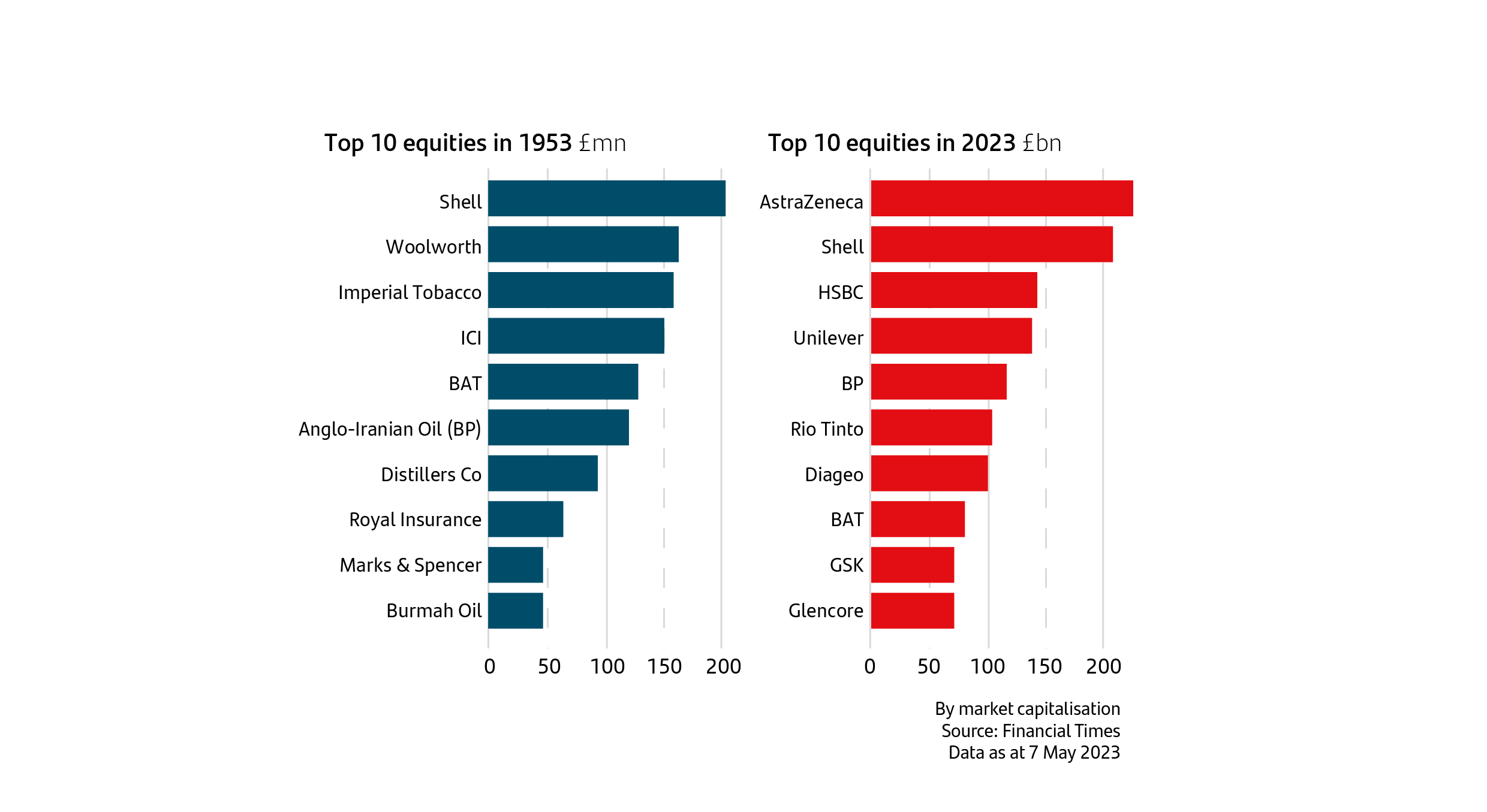
Over the Coronation weekend, a fascinating article was published by the Financial Times, comparing the difference in the UK stock market in the 70 years since our late Queen was crowned. It showed the difference in the top 10 companies by market value. Inflation at the time was 10%, but by the year-end it had slowed to 3% (the predictions are similar for 2023), the yield on bonds was 5%, and the dividend yield on shares was 5%, according to Mike Staunton of the London Business School, when compared with just over 4% today. In addition, it measured the annualised return from shares, bonds and cash over the 70 years and compared this against inflation during these seven decades to highlight the ‘real’ return investors would have achieved.
Equities have beat bonds and cash since 1953
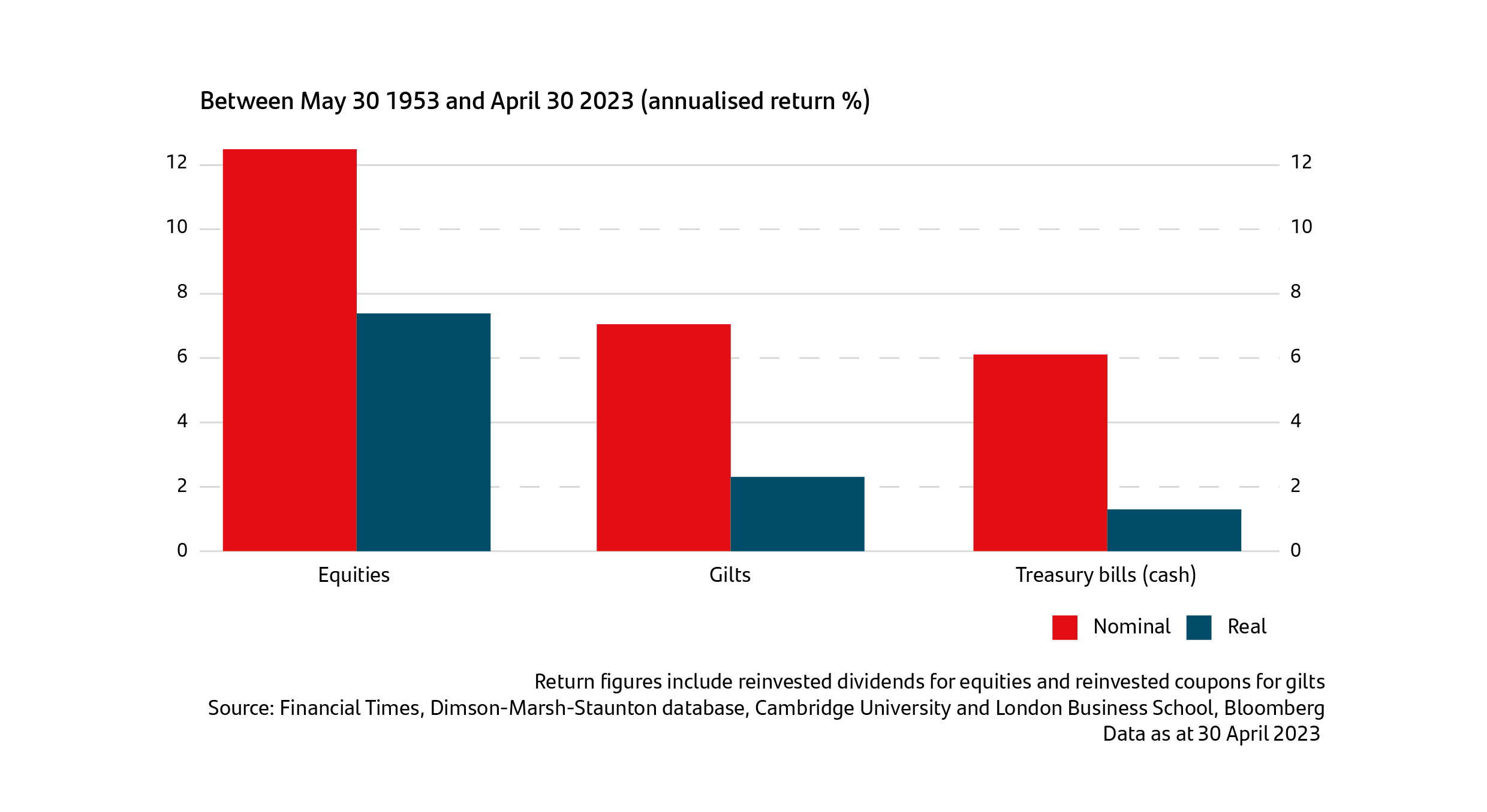
Obviously, investing over 70 years is not the norm, as we only tend to accumulate sufficient savings to be able to invest much later in our lives, but I think the article does a really good job of highlighting the benefits of investing. One key takeaway is time. The longer you can invest, the more patient you can be, withstanding the need to access your investment too early, which helps increase the probability of achieving an investment return in excess of inflation.
Also, the article focuses on the UK market, which back in 1953 made up a more significant chunk of the world stock market than it does today. In the last 20 years, because the UK market sectors are more old-fashioned and have less exposure to technology and growth companies, it has lagged its international peers. If we take a more recent example of how different asset classes have performed, the chart below uses the global share index from MSCI and the Barclays Global Bond Index, measuring them both against inflation, the UK base rate and the Moneyfacts 90 Day rate for a £10,000 savings balance. What it shows is that shares over longer time periods perform much better than cash and beat inflation. Clearly, past performance is not a guide to the future returns you can expect, but history shows that investing provides a greater chance of growing your real wealth than just relying on your savings.
Equities outperform
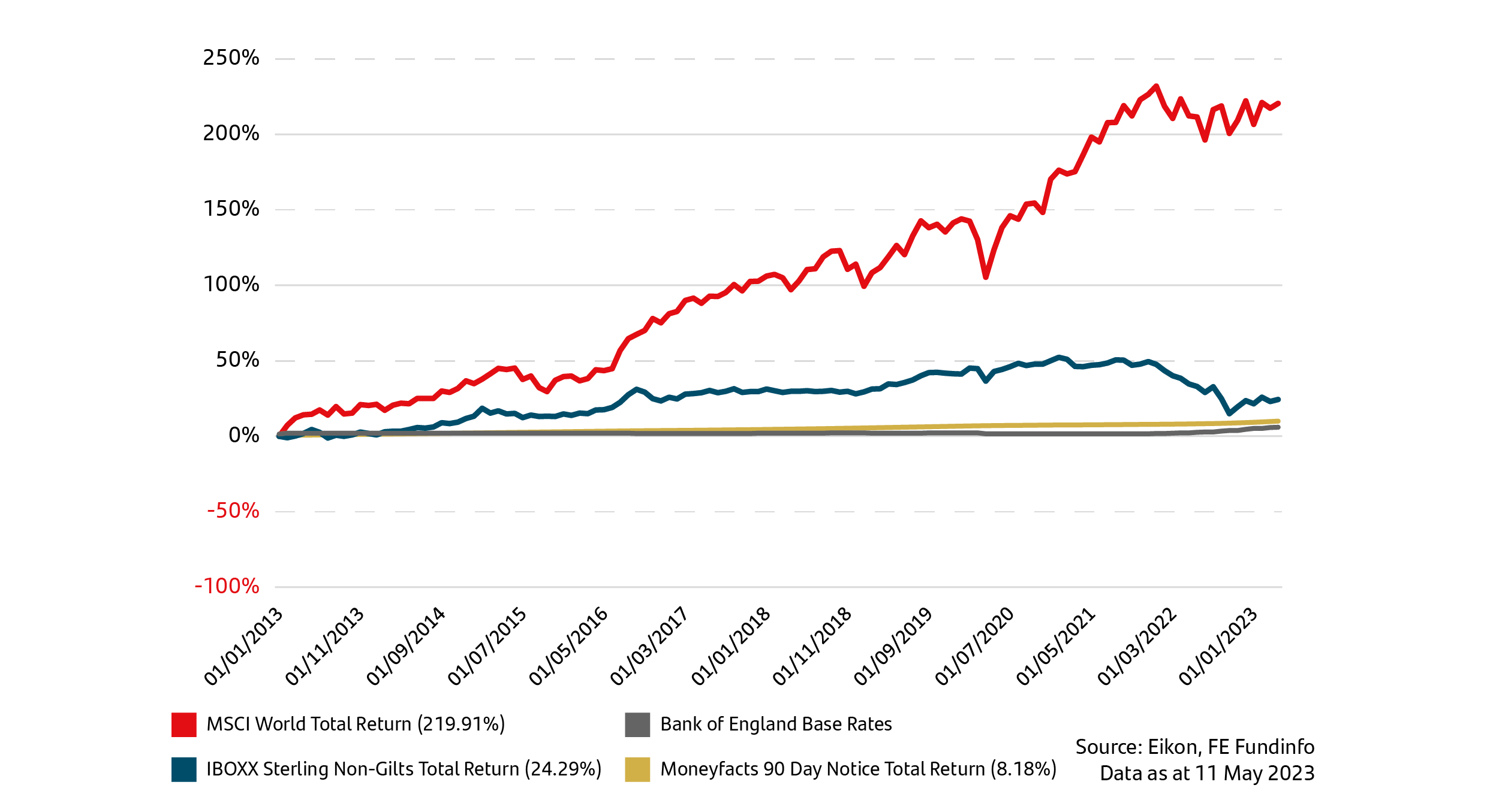
The value of seeking guidance and advice
It is important to seek advice and guidance from a professional financial adviser who can help to explain how to build an appropriate financial plan to match your time horizons, financial ambitions, and risk comfort. If you already have a plan in place, or have already invested, it is important to allocate time to review this to ensure this remains on track and appropriate for your needs.
Note: Data as at 11 May 2023. 1Bank of England, 9 May 2023. 2Guardian Newspaper, 7 May 1997. 3Money Saving Expert, 9 May 2023. 4Bank of England Inflation Calculator, 9 May 2023. 5FE Analytics, 9 May 2023. 6Financial Services Compensation Scheme, 9 May 2023,

Investing can feel complex and overwhelming, but our educational insights can help you cut through the noise. Learn more about the Principles of Investing here.
Important information
For retail distribution. This document has been approved and issued by Santander Asset Management UK Limited (SAM UK). This document is for information purposes only and does not constitute an offer or solicitation to buy or sell any securities or other financial instruments, or to provide investment advice or services. Opinions expressed within this document, if any, are current opinions as of the date stated and do not constitute investment or any other advice; the views are subject to change and do not necessarily reflect the views of Santander Asset Management as a whole or any part thereof. While we try and take every care over the information in this document, we cannot accept any responsibility for mistakes and missing information that may be presented.
All information is sourced, issued and approved by Santander Asset Management UK Limited (Company Registration No. SC106669). Registered in Scotland at 287 St Vincent Street, Glasgow G2 5NB, United Kingdom. Authorised and regulated by the FCA. FCA registered number 122491. You can check this on the Financial Services Register by visiting the FCA’s website www.fca.org.uk/register




